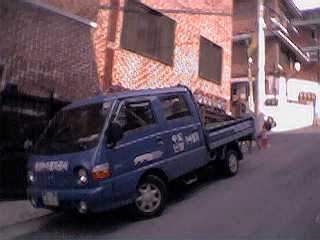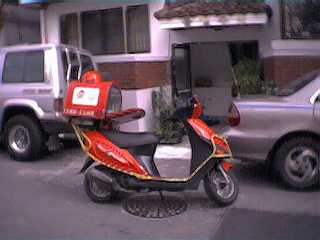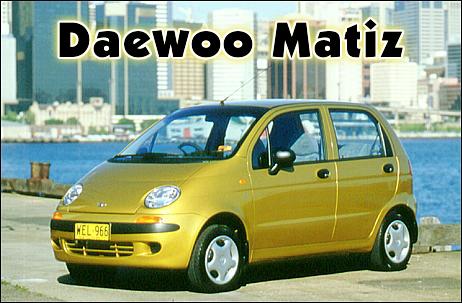More Driving in Korea
Seoul has a carefully laid out network of wide,
multilane (2 to 6 lanes in each direction) major streets
which were established after the Korean war. The most
challenging aspect of these roads (other than the great
number of cars, is the transition of lanes. Lanes start
and stop with no particular pattern. If you know you need
to be in the right lane and just follow a lane, you may
find yourself in the left lane as lanes start and stop
unexpectedly. Between the major streets are a maze of
narrow streets which are more like alleys. If they are
wide enough for two cars, parking usually reduces them
back to one lane. The rest of the country has a network
of modern expressways which lead to a local road system
which winds through the mountains.
The traffic mix is part of the problem. The trucks and
buses do whatever they have to do to get through. Cars
dodge around them when they can. A hoard of delivery
motorcycles fill in any voids. The motorcycles may have
any kind of rack or brace sticking out, so they are a
real hazard to pedestrians. As they continue to build new
subways and improve the infrastructure, you can count on
construction every few miles. Sometimes it moves pretty
well and sometimes it's gridlock.

This is a "crew cab" Bongo. Actually the Kia
trucks are Bongo's and the Hyundai version is the Porter.
They look alike and we call them all Bongos. The most
interesting feature is that they have two different size
tires. The fronts are 14" and the back has dual
12" tires. This allows a lower flat bed. The short
sides hinge down for loading and oversize loads.

This is a microvan. There is a whole series of micro
cars, vans and trucks available. They are as tiny as they
look but, believe it or not, this thing is advertised to
carry 7 people (2+2+3 configuration). Two side by side
are crowded. Three in the back would have to be very
small people.

This is a Pizza Hut delivery vehicle. At least it has
a built in storage compartment. Most of the restaurant
delivery is done with large aluminum carriers via
motorcycle. The catch is that there is no way to attach
the carrier to the bike. So the rider holds it in his
hand as he speeds down the streets and alleys and
sidewalks. I've never seen one crash but you see close
calls every day.

This is the most popular micro car. In an attempt to
reverse the trend toward larger cars, they are offering
options like air bags and a CVT (constantly variable
transmission). The price is also quite low. However, I'm
not sure if this makes up for the small size and
relatively weak 800 cc engine. These are being exported
to many Asian countries.
You can successfully drive here once
you learn a couple of things. One is that you can't let
your attention lapse for a moment. Cars, buses and
motorcycles can come from anywhere at any time. The other
thing is that the rules don't seem to apply to everyone.
Buses, in particular, only stop at red lights if there
seems to be a good reason. If someone ends up in the
wrong lane and needs to cross 4 lanes of busy traffic to
make a turn, he does it. No one gets too upset as they
seem to understand that these things happen and expect
it.
I was able to get an English language copy of the Driver
Manual when I got a drivers license. It's usually easy to
make fun of translated documents but this one was really
very good. It actually has a lot more useful information
than most U.S. driving books put out by the states. There
were a couple of items that left me scratching my head
though. One was "Drivers make sure that passengers
are not disturbing them, dancing in the car." The
other, in the section on security was "If you are
abducted in a vehicle, do everything in your power not to
disturb traffic in your immediate vicinity including
rescuers and police officers."
U.S. and European cars can be seen here but most are
owned by either U.S. Army personnel or diplomatic
personnel. The Korean industry makes a big deal about how
much imports have increased but the total is only a few
thousand cars per year. Almost all are luxury cars
because it doesn't make sense to pay the import duties on
an average car.



